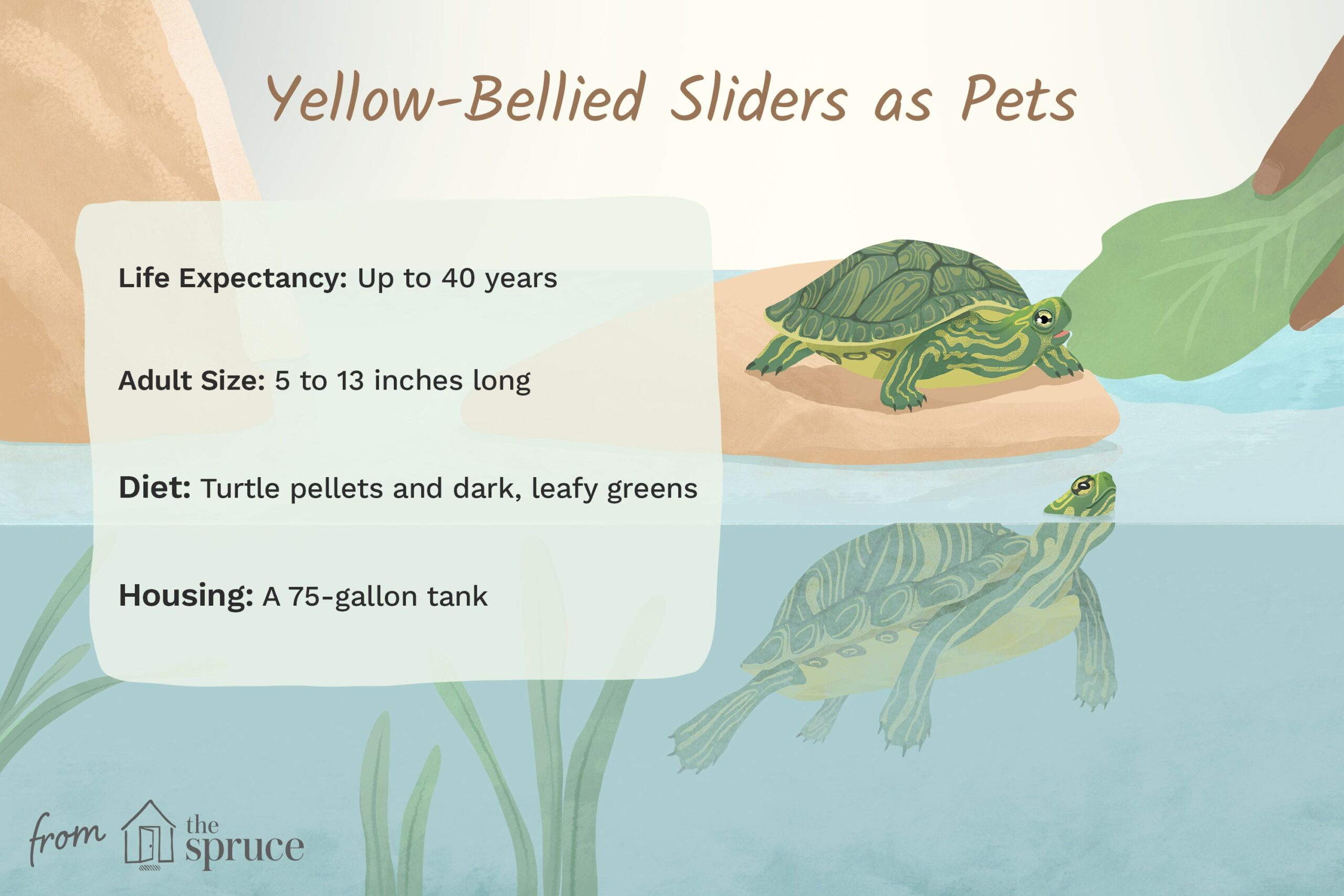To care for a yellow belly turtle, provide clean water, a basking area, and a balanced diet. Regularly clean the tank and monitor water temperature for optimal health.
Yellow belly turtles are fascinating creatures that require proper care to thrive in captivity. By understanding their specific needs and providing a suitable environment, you can ensure your turtle stays healthy and happy. In this guide, we will explore the essential aspects of caring for a yellow belly turtle, including habitat setup, diet recommendations, and common health concerns.
Whether you are a new turtle owner or looking to enhance your existing care routine, this information will help you provide the best possible care for your yellow belly turtle.

Credit: www.youtube.com
Setting Up The Habitat
Setting up the habitat for your yellow belly turtle is crucial to ensuring its health and well-being. Creating a suitable environment involves several key factors, including tank size and setup, temperature and lighting requirements, as well as filtration and water quality.
Tank Size And Setup
When setting up the habitat for your yellow belly turtle, it’s important to provide a spacious tank that allows for both swimming and basking. A general rule of thumb is to allocate at least 10 gallons of water per inch of shell length.
Additionally, include a basking area with a platform or rock that the turtle can easily climb onto. This area should be equipped with a heat lamp and a UVB light to support the turtle’s thermoregulation and calcium metabolism.
Temperature And Lighting Requirements
Maintaining the appropriate temperature and lighting is essential for the well-being of your yellow belly turtle. The water temperature in the tank should be kept between 75-80°F (24-27°C), while the basking area should reach 85-90°F (29-32°C).
UVB lighting is crucial for the turtle’s shell and bone health, so ensure the tank is equipped with a UVB light that is replaced every 6-12 months to maintain its effectiveness.
Filtration And Water Quality
Proper filtration and water quality are vital for the health of your yellow belly turtle. Invest in a high-quality filter that can effectively cycle and clean the water in the tank.
Regular water changes, typically around 25% every 2-4 weeks, are necessary to maintain optimal water quality. Use a dechlorinator to treat tap water before adding it to the tank to remove harmful chemicals.
Feeding And Diet
Proper feeding and diet are essential for the well-being of a Yellow Belly Turtle. Offer them a balanced diet that includes both animal and plant-based foods, as well as supplements like calcium and vitamin D3. Providing clean water and monitoring their eating habits can also aid in their care.
Yellow Belly Turtles are omnivores, which means they eat both plants and animals. It’s important to provide a balanced diet to keep your pet healthy and happy. Here are some tips on feeding and diet for your Yellow Belly Turtle.Balanced Diet
A balanced diet for a Yellow Belly Turtle should consist of 50% protein and 50% vegetables and fruits. This will help ensure that your pet receives all of the necessary nutrients to maintain good health.Feeding Schedule
Young Yellow Belly Turtles should be fed every day, while adults can be fed every other day. It’s important not to overfeed your pet, as this can lead to obesity and other health problems.Food Options
There are many different options for feeding your Yellow Belly Turtle. Here are some examples:- Commercial turtle food pellets
- Live or frozen fish
- Shrimp
- Cricket
- Mealworms
- Dark leafy greens
- Carrots
- Squash
- Fruits such as apples, bananas, and strawberries
Handling And Interaction
Handling and interacting with your yellow-bellied turtle is an essential part of providing proper care. It’s important to approach and handle these creatures with caution and respect, as they may feel stressed or threatened if not handled properly. Building a bond with your turtle can also enhance its well-being and create a more enjoyable experience for both you and your pet.
Proper Handling Techniques
When handling your yellow-bellied turtle, it’s crucial to do so gently and with care. Always approach the turtle slowly and avoid sudden movements that may startle it. Support the turtle’s body properly, ensuring that its legs and head are fully supported to prevent any stress or injury. Avoid lifting the turtle by its shell, as this can cause harm and discomfort. It’s best to handle them close to the ground or over a soft surface to prevent any potential falls or injuries.
Creating A Bond With Your Turtle
Building a bond with your turtle can be a rewarding experience for both you and your pet. Spending time with your turtle can help it become familiar with your presence and develop trust. Interact with your turtle by offering it food by hand, gently petting its shell, or talking to it in a soothing voice. However, always be mindful of the turtle’s comfort and body language, as they may not always enjoy extensive handling or interaction. Over time, you can create a strong bond based on mutual trust and understanding.

Credit: www.amazon.com
Health And Hygiene
When it comes to caring for a yellow belly turtle, ensuring their health and hygiene is crucial. By maintaining a clean and healthy environment, you can help your turtle thrive. In this section, we will discuss the signs of illness to watch out for, the importance of regular health check-ups, and the cleaning and maintenance routines necessary for your turtle’s well-being.
Signs Of Illness
If you notice any of the following signs, it may indicate that your yellow belly turtle is unwell:
- Decreased appetite
- Lethargy or lack of activity
- Abnormal swelling or lumps
- Discharge from the eyes, nose, or mouth
- Changes in shell or skin color
Regular Health Check-ups
It’s essential to schedule regular check-ups with a reptile veterinarian to ensure your turtle’s well-being. A qualified vet can perform thorough examinations, provide dietary recommendations, and address any health concerns.
Cleaning And Maintenance
Proper cleaning and maintenance are essential for keeping your yellow belly turtle healthy. This includes:
- Regular water changes to maintain water quality
- Thorough cleaning of the tank and accessories
- Providing a basking area with proper UVB lighting
- Ensuring a balanced diet and proper hydration
Behavioral Enrichment
When caring for a yellow belly turtle, it’s crucial to provide behavioral enrichment to ensure their physical and mental well-being. Behavioral enrichment involves providing stimulating activities and creating an enriching environment that mimics their natural habitat, ultimately promoting their overall health and happiness.
Providing Stimulating Activities
Yellow belly turtles thrive when engaged in stimulating activities that encourage natural behaviors. Here are some stimulating activities to keep your turtle active and happy:
- Introduce floating objects for exploration and interaction
- Offer live food for hunting and feeding stimulation
- Provide a variety of safe plants for grazing and hiding
Creating An Enriching Environment
An enriching environment is essential for the well-being of yellow belly turtles. Consider the following tips to create a habitat that encourages natural behaviors:
- Ensure a spacious tank or enclosure with ample swimming and basking areas
- Use natural substrates such as sand or gravel to mimic their natural habitat
- Include basking platforms and hiding spots for security and relaxation
Breeding And Reproduction
When it comes to the breeding and reproduction of yellow belly turtles, it’s essential to understand their reproductive process and how to care for the hatchlings. Here, we will delve into the important aspects of breeding and reproduction for these fascinating creatures.
Understanding The Reproductive Process
Yellow belly turtles reach sexual maturity between 5 to 7 years of age. The mating process typically occurs in water, where the male turtle will court the female through various displays and movements. Once the mating is successful, the female will seek out a suitable nesting site on land to lay her eggs. A typical clutch size can range from 4 to 20 eggs, depending on the size and health of the female.
Caring For Hatchlings
After an incubation period of 70 to 120 days, the hatchlings will emerge from their eggs. It’s crucial to provide a nurturing environment for the young turtles. A shallow water area with easy access for the hatchlings is essential, along with basking areas for them to dry off and regulate their body temperature. Feeding the hatchlings a diet rich in protein and calcium is vital for their growth and development.

Credit: www.reddit.com
Conclusion
Taking care of a Yellow Belly Turtle requires dedication and proper knowledge. By providing a suitable habitat, balanced diet, and regular veterinary check-ups, you can ensure the well-being of your pet. Remember to maintain cleanliness and monitor their behavior closely for any signs of distress.
Your Yellow Belly Turtle will thrive with your attentive care.






Leave a Reply